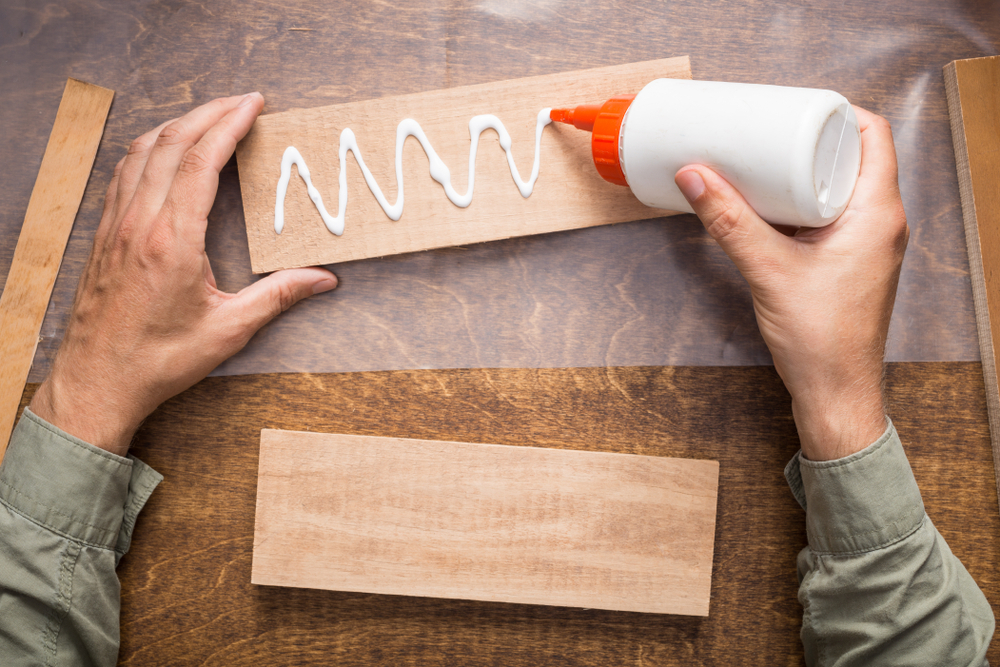Liquid Nails and wood glue are both adhesives that are commonly used to join wood pieces together. However, there are some key differences between the two products that can make one more suitable for a particular task than the other.
Liquid Nails is a heavy-duty construction adhesive that is specifically designed for use on wood and other porous building materials. It is a strong adhesive that is resistant to water and can withstand extreme temperatures. It is also resistant to shrinkage and expansion, which makes it ideal for use in outdoor projects. However, it takes longer to set than wood glue, and it is more difficult to work with because it is thick and sticky. It is also more expensive than wood glue.
Wood glue, on the other hand, is a specialized adhesive that is specifically designed for use on wood. It is typically made from a synthetic polymer that is designed to bond strongly with wood fibers. Wood glue is generally less expensive than Liquid Nails and is easier to work with because it is thinner and less sticky.
It also sets more quickly than Liquid Nails, which makes it easier to make adjustments to the project if needed. However, wood glue is not as strong as Liquid Nails and is not as resistant to water and extreme temperatures. It is also prone to shrinkage and expansion, which can make it less suitable for outdoor projects.
In general, Liquid Nails is a better choice for heavy-duty projects that require a strong, waterproof adhesive, while wood glue is a better choice for projects where a strong bond is not as important, or where the adhesive needs to be easier to work with.
How to use Liquid Nails
Liquid Nails is a heavy-duty construction adhesive that is specifically designed for use on wood and other porous building materials. It is a strong adhesive that is resistant to water and can withstand extreme temperatures, making it ideal for use in outdoor projects. Here are some tips on how to use Liquid Nails:
- Make sure the surfaces you want to bond are clean and dry. Liquid Nails will not bond well to dirty or wet surfaces.
- Cut the nozzle of the Liquid Nails tube to the desired size, using a pair of scissors or a utility knife. A smaller nozzle will allow you to apply the adhesive more precisely, while a larger nozzle will allow you to apply it more quickly.
- Apply the adhesive to one of the surfaces you want to bond. You can apply it in a continuous bead or in small dots, depending on your preference.
- Press the two surfaces together firmly, making sure to align them properly.
- Hold the surfaces in place for at least 10-15 minutes to allow the adhesive to set.
- If you need to make adjustments to the project, you can use a scraper or putty knife to remove excess adhesive before it sets.
- Allow the adhesive to dry completely before sanding or painting the project. The drying time will depend on the humidity and temperature, but it typically takes at least 24 hours for Liquid Nails to dry completely.
It’s important to follow the manufacturer’s instructions and use caution when working with Liquid Nails, as it can be difficult to remove once it has set. Wear gloves to protect your hands and avoid getting the adhesive on your skin or clothing. If you do get it on your skin, use soap and water to wash it off. If it gets on your clothing, it may be difficult to remove and may require special treatment.
How to use Wood Glue
Wood glue is a specialized adhesive that is specifically designed for use on wood. It is typically made from a synthetic polymer that is designed to bond strongly with wood fibers. Wood glue is generally less expensive than Liquid Nails and is easier to work with because it is thinner and less sticky. It also sets more quickly than Liquid Nails, which makes it easier to make adjustments to the project if needed. Here are some tips on how to use wood glue:
- Make sure the surfaces you want to bond are clean and dry. Wood glue will not bond well to dirty or wet surfaces.
- Apply the glue to one of the surfaces you want to bond. You can apply it with a brush, a roller, or by squeezing it directly from the bottle or tube.
- Press the two surfaces together firmly, making sure to align them properly.
- Use clamps or weights to hold the surfaces in place until the glue sets. The drying time will depend on the humidity and temperature, but it typically takes at least an hour for wood glue to set completely.
- If you need to make adjustments to the project, you can use a scraper or putty knife to remove excess glue before it sets.
- Allow the glue to dry completely before sanding or painting the project. The drying time will depend on the humidity and temperature, but it typically takes at least 24 hours for wood glue to dry completely.
It’s important to follow the manufacturer’s instructions and use caution when working with wood glue, as it can be difficult to remove once it has set. Wear gloves to protect your hands and avoid getting the glue on your skin or clothing. If you do get it on your skin, use soap and water to wash it off. If it gets on your clothing, it may be difficult to remove and may require special treatment.
In conclusion
Liquid Nails and wood glue are both adhesives that are commonly used to join wood pieces together. However, there are some key differences between the two products that can make one more suitable for a particular task than the other.
Liquid Nails is a heavy-duty construction adhesive that is specifically designed for use on wood and other porous building materials. It is a strong adhesive that is resistant to water and can withstand extreme temperatures. It is also resistant to shrinkage and expansion, which makes it ideal for use in outdoor projects. However, it takes longer to set than wood glue, and it is more difficult to work with because it is thick and sticky. It is also more expensive than wood glue.
Wood glue, on the other hand, is a specialized adhesive that is specifically designed for use on wood. It is typically made from a synthetic polymer that is designed to bond strongly with wood fibers. Wood glue is generally less expensive than Liquid Nails and is easier to work with because it is thinner and less sticky. It also sets more quickly than Liquid Nails, which makes it easier to make adjustments to the project if needed. However, wood glue is not as strong as Liquid Nails and is not as resistant to water and extreme temperatures. It is also prone to shrinkage and expansion, which can make it less suitable for outdoor projects.
In general, Liquid Nails is a better choice for heavy-duty projects that require a strong, waterproof adhesive, while wood glue is a better choice for projects where a strong bond is not as important, or where the adhesive needs to be easier to work with.

